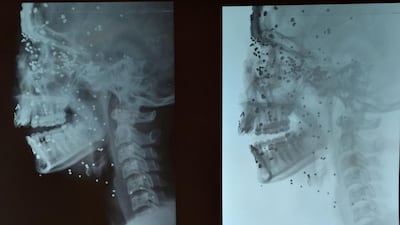NEW DELHI // Indian security forces struggling to quell unrest in Kashmir have come under increasing fire for their use of pellet guns, which have inflicted horrific injuries on protesters and filled hospitals with victims suffering from multiple puncture wounds.
At least 41 people, including 39 civilians and two policemen, have been killed and around 2,000 injured since protests broke out following the July 8 killing of a young Kashmiri militant, Burhan Wani.
These protests quickly turned violent as, amid curfews and a telecommunications blockade, young Kashmiris began pelting troops with stones.
Troops have responded with tear gas, as well as occasional bursts of live ammunition. But proving most controversial is their widespread use of pellet guns, which were introduced by security forces in Kashmir after the last major wave of civil unrest in 2010.
“The idea was to stop using regular rifles, which lead to much heavier casualties, and to instead use a weapon with limited force,” said Vivek Chadha, a retired Indian army colonel and research fellow at the Institute for Defence Studies and Analyses in New Delhi. “But a limitation of the pellet gun,” in terms of the human damage it can cause, “does seem to be emerging.”
The guns shoot small metal balls, slightly larger than a grain of sand and sometimes covered in rubber. Indian forces use both the plain metal balls and the rubber-coated ones, which are designed to minimise damage. One cartridge can pack as many as 600 pellets, which are sprayed out in every direction at high speeds of over 1,000 feet per second.
The guns are used for riot control in other parts of the world, including the United States, Israel, Bolivia, Egypt, Canada and South Africa. Objections to the guns have arisen in these countries as well.
But while the Indian army claims that pellet guns – classified as Kinetic Impact Projectiles (KIPS) – are non-lethal weapons, a report this year by Physicians for Human Rights said that KIPs “have the same ability to penetrate the skin as conventional live ammunition and can be just as lethal”.
“When launched or fired from afar, these weapons are inaccurate and strike vulnerable body parts, as well as cause unintended injuries to bystanders,” the report said.
Mr Chadha also pointed out that if pellets guns were fired from close range, or at sensitive parts of the body such as the face, “they tend to do far more damage, as we’re seeing in Kashmir”.
Hundreds of people with pellet injuries have streamed into hospitals in Srinagar, the biggest city in Kashmir. A single Srinagar hospital, the Shri Maharaja Hari Singh Hospital, has performed 117 surgeries on pellet victims since July 8, according to the Indian Express newspaper.
Many pellet victims have suffered tiny, hard-to-treat fractures in their skulls, as well as irreversible damage to their eyes. On Wednesday the Indian government sent three eye specialists to Srinagar to treat eye injuries from pellets.
One of the victims is 14-year-old Insha Malik, whose photograph revealing swollen eyes and a face covered in puncture wounds was circulated widely on social media on Thursday. Insha was looking out of her open kitchen window at clashes in the street on Tuesday when dozens of pellets struck her face. After operating on her, doctors told Kashmiri newspapers that her vision was unlikely to return. Separately, a number of pellets remain lodged inside Insha’s head, too deep to remove and still liable to cause further damage.
Yet despite the permanent damage caused to civilians and bystanders such as Insha, the Jammu and Kashmir state government has claimed that pellet guns are indispensable to its efforts to maintain law and order.
“We disapprove of it,” said Nayeem Akhtar, the minister for education in the state government. “But we will have to persist with this necessary evil till we find a non-lethal alternative.”
Abdul Mannan Bukhari, a senior leader in the All Parties Hurriyat Conference, a pro-Kashmiri independence alliance of 26 political and religious groups, has said the pellet gun symbolises “the brutal face of suppression” by India in Kashmir.
"Since 2010, hundreds of Kashmiris have been disabled by the use of pump action pellet guns used by the government forces," Mr Bukhari wrote in his 2015 book, Kashmir: Scars of Pellet Guns.
“Vital veins and arteries of some of the victims had been torn beyond repair leading to amputations.”
Both Human Rights Watch and Amnesty International have called for an end to the use of pellet guns.
“When the police are trying to contain violent persons, it is important that they focus any use of force accurately at those individuals,” Shemeer Babu, the programmes director at Amnesty International India, said last year. “However, pellet guns cannot ensure well-targeted shots and risk causing serious injury, including to bystanders or other protesters not engaging in violence.”
Mr Chadha said it was often difficult for security forces to gauge appropriate levels of force during confrontations.
“It is a fact that, in these protests, policemen have been drowned or hit with rods or shot. It is a fact that militants with grenades sometimes hide within the protesting crowds,” he said. “So courses of action are not always clear-cut.”
But he acknowledged that the incidents of pellet gun injuries in the recent unrest have been gruesome enough to warrant a re-examination of the use of the weapon.
“Once this wave of protests has subsided and order has been restored, I’m sure the security forces will want to take another look at the pellet gun, and will be willing to look at other solutions.”
ssubramanian@thenational.ae

